A Guide to The Souks and Spice Markets of the Middle East and North Africa
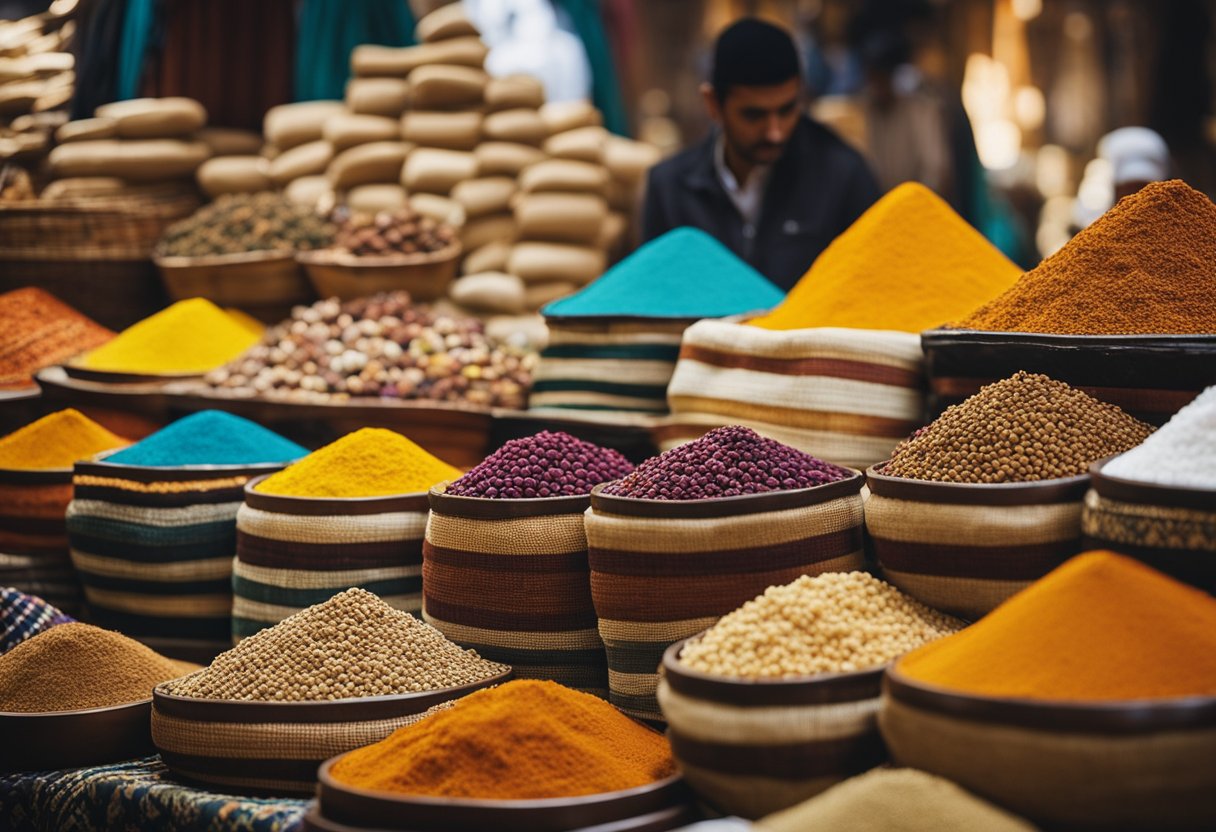
Updated On: April 25, 2024 by Maha Yassin
Venturing into the bustling labyrinth of a Middle Eastern or North African souk offers an immersive journey through the veins of ancient commerce and enduring cultural traditions. These marketplaces, each a vibrant tapestry of scents, sounds, and colours, serve as social and economic activity hubs. In cities such as Marrakech and Istanbul, the souks and spice markets are not merely retail spaces; they stand as living museums that record the ebb and flow of civilisations, where the art of haggling echoes the past and craftsmanship takes centre stage.
The structure of a souk, with its narrow alleys lined by small stalls and shops, demonstrates a complex market layout designed over centuries. Spices pile high, forming aromatic landmarks in the congested corridors. At the same time, jewellers and metalworkers showcase their gleaming wares—each piece a testament to the region’s role in the historic trade of precious materials. Textile markets ripple with the finest fabrics, featuring patterns and weaves that tell stories of wanderers and caravans traversing deserts under starlit skies. Here, touch and taste are not just senses but keys to unlocking the soul of places steeped in an alchemy of cultures and traditions.
The Historical Evolution of Middle Eastern and North African Souks
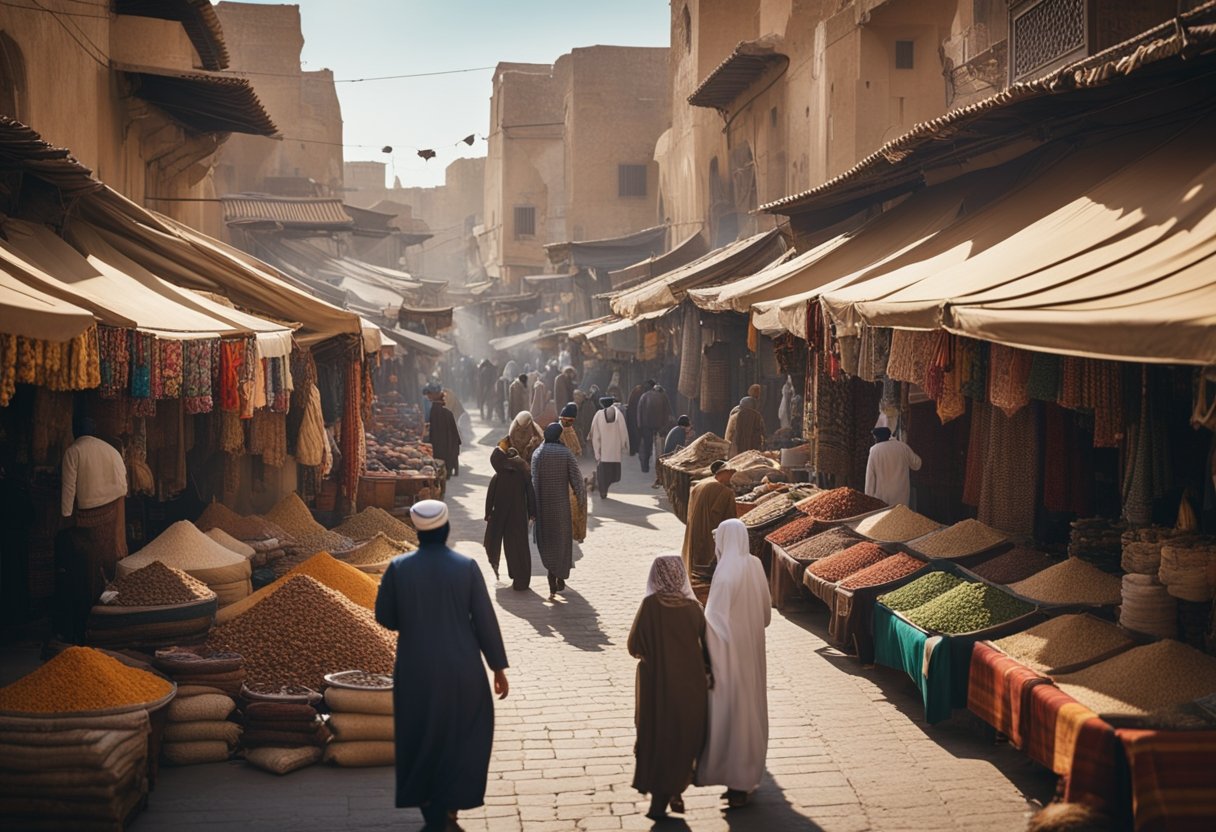
The souks and spice markets of the Middle East and North Africa have been pivotal to the heritage and culture of these regions. Historically, these marketplaces served as centres for trade and social hubs where information and ideas were exchanged alongside goods like spices, silks, and precious metals.
The Silk Road, an ancient network of trade routes, significantly influenced the development of souks across the Middle East. This intercontinental pathway enriched the material and cultural wealth of the connected regions. For example, the famed Dubai Spice Souk offers an array of exotic spices reflecting the city’s historical role as a trading port.
Many of these marketplaces, such as the Gold Souk in Old Dubai, have historical roots that trace back several centuries. These bazaars were not only centres for commerce but also contributed to the social fabric of their cities, strengthening community ties and cultural identity.
In North Africa, the story is similar. The markets are often filled with traditional items showcasing the region’s heritage, including textiles, pottery, and spices. The markets serve as living museums, representing the confluence of cultures that have interacted over millennia, from native Berbers to Arab and Mediterranean influences.
Dates, another key product, are more than just a staple food item; they’re part of the region’s soul, often used in local cuisine and for welcome rituals, signifying hospitality.
Through this historical evolution, Middle Eastern and North African souks have become celebrated landmarks, contributing to the rich tapestry of spice souks intricately woven with tales of merchants, craftsmen, and travellers from days past.
Anatomy of the Souk: Structure and Market Layout
When we visit a souk, we’re stepping into a labyrinth of commerce that’s as rich in history as merchandise. The classic souk structure is a collection of narrow alleys, lined on each side with small stalls, often shaded by a patchwork of awnings. While seemingly chaotic, the layout of these markets follows a traditional organisation where vendors selling similar goods cluster together.
One of the most well-known souks in Dubai is the Deira Spice Souk. As we navigate the vibrant alleys, we notice the stalls brimming with traditional spices, their colours and scents defining the souk’s atmosphere. Nearby, the Gold Souk in Al Ras shines with the intricate work of local jewellers. Here, rows of shops display an array of gold and precious stones, with shopkeepers conversing with buyers in a harmonious haggle.
Vendor stalls are typically open at the front, allowing for a free flow of patrons and the sharing of scents and sounds. At some souks, like Souk Madinat, the old blends with the new, as traditional market aesthetics are combined with modern amenities, offering comfort and authenticity.
Transporting us across the creek, an abra ride gives a panoramic view of the creek-side souk architecture, featuring wind towers and wooden arches that recall the market’s historical roots. As each souk has its character, the specific layout and assortment of goods reflect its location’s cultural and commercial heritage. Our understanding of the region’s trade and social patterns grows deeper as we explore these age-old marketplaces.
In summary, the anatomy of a souk encompasses more than a simple market layout—it’s the cultural heartbeat of the Middle Eastern and North African trading world.
Cultural Significance and the Art of Haggling
In the bustling alleys of the Middle Eastern and North African souks, haggling is more than just a transaction method—it’s a pivotal aspect of the local experience. As we navigate through the vibrant stalls of the Dubai souks, it’s clear that bargaining is not purely about financial gain but is deeply intertwined with the region’s culture.
Haggling is as much a social ritual as it is an economic one. It reflects a long-standing tradition where buyers and sellers engage in a friendly battle of wits. For many vendors, negotiation is a skill handed down through generations, and prices are rarely set in stone but are seen as a starting point for discussion. This practice allows for a mutually beneficial outcome where both parties reach a satisfactory agreement.
Dubai souks, just like their counterparts across the region, serve as hubs where traditions are preserved and celebrated. The array of items on offer, from spices to textiles, are often the products of local artisans and traders. As we partake in this age-old practice of negotiation, our exchanges go beyond mere purchasing; they are a form of cultural connection and respect.
The art of bargaining demands patience and a keen sense of respect. Here’s a simple guide to haggling etiquette:
- Start friendly: Establish rapport with the seller.
- Know the value: Do some research to understand the fair price range.
- Offer reasonably: Begin by suggesting a price lower than the asking price, but not offensively so.
- Read cues: Listen to the vendor’s body language and adjust your approach accordingly.
- Be prepared to walk away: Sometimes, the best way to settle on a price is to show a willingness to leave.
Through this intricate haggling dance, we connect with a key aspect of the local marketplace culture, gaining insights into Middle Eastern and North African ways of life. Engaging in the negotiable nature of the market not only secures souvenirs but also forges a deeper appreciation for the region’s customs and people.
Exploring the Rich Aroma of Spice Markets
The Spice Souks of the Middle East and North Africa are sensory hubs where the air is thick with the enchanting aromas of spices. We navigate through narrow alleyways, each turn offering fragrant incense, the woody scent of oud, and the subtle notes of handmade perfumes.
Venturing deeper into the market, we find heaps of saffron threads glowing with their vibrant crimson hue. This authentic treasure is coveted for its colour and flavour, infusing dishes with its distinct essence.
- Incense and Bakhoor: Smouldering frankincense offers a deep, resinous fragrance, while bakhoor, a form of scented bricks made from agarwood, fills the air with a warm, smokey aroma.
- Oud: Extracted from the Agar tree, considered liquid gold among perfumes, oud exudes a powerful, musky scent.
- Spices: The spice stalls themselves are mosaics of colours and textures. Vendors proudly showcase their goods, providing a rich tapestry of cinnamon, cardamom, nutmeg, and more.
The Spice Souk experience is about more than just the senses; it’s an insight into centuries-old trade practices that continue to thrive. We share the traders’ passion for their products, a joy palpably felt within these markets’ spirited exchanges.
As we immerse ourselves in these aromatic expanses, we embrace the traditional alongside the innovative, timeless scent of the past, blending with the vibrant pulse of the present. This journey through the scent-filled laneways offers us a glimpse into the soul of local cultures – a cherished chapter in our continuous exploration of the world’s diversity.
A Dive into Gold and Jewellery Markets
In luxury and fine craftsmanship, gold and jewellery markets in the Middle East and North Africa are unrivalled. Here, the allure of gold gleams brightly, beckoning shoppers and collectors alike to treasures that span traditional and contemporary designs.
Gold Souk in Dubai
The Gold Souk in Dubai is a testament to the city’s robust trade in precious metals and stones. Frequented by connoisseurs and tourists, this bustling market is one of the most renowned gold bazaars globally, offering items ranging from delicate silver pieces to the most extravagant gold and diamond jewellery. Every visit allows for splendid encounters with lavish displays, as the souk hosts an awe-inspiring selection of rings, necklaces, bracelets, and earrings. Customers can witness the finesse of gold shaping, purchase luxury items, and even haggle for better prices under the warm glow of countless displays.
Gold Markets Across the Gulf
Throughout the Gulf, gold markets reflect the region’s storied history with the precious metal, with an abundance of markets specialising in gold, silver, and fine jewellery. The richness of Arabic designs, often embellished with precious stones, cater to every taste, from subtle elegance to bold statements. It’s essential to grasp that these markets offer more than a commercial transaction; they are deeply rooted in the culture, representing a legacy of trade and artisanship. In countries like Saudi Arabia, Qatar, and Bahrain, such markets highlight gold’s role in everyday life and grand occasions, cementing the Gulf’s reputation for unmatched quality and stunning designs.
Textile and Handicraft Bazaars: A Tapestry of Tradition

In the heart of the Middle East and North Africa, textile and handicraft bazaars are enduring cultural heritage emblems. Here, we are enveloped in a world where traditional textile souks offer a dazzling array of fabrics, from silk to lace, each piece a testimony to the region’s artisanal skill.
Tailors and craftspeople work with a precision passed down through generations. Their nimble fingers weave intricate patterns into rugs and cloths, creating pieces sought after for their beauty and craftsmanship. Various handicrafts serve as unique souvenirs, ensuring visitors take a slice of local tradition.
Textiles:
- Silk: Prized for its softness and lustrous beauty.
- Lace: Delicate and ornate, often used in traditional garments.
- Fabrics: A vibrant selection, including hand-embroidered cloths.
Crafts:
- Rugs: Each knot is tied using centuries-old techniques.
- Souvenirs: Handmade items ranging from small trinkets to opulent tapestries.
Visitors can find a tapestry of tradition rich with history in these bazaars. The air is heavy with the scent of dyed wool and the bustling sounds of haggling, as each piece is more than a product—it’s a narrative of the hands that crafted it. We witness the persistence of traditional methods as artisans boldly maintain the customs that have defined their work for centuries.
Souvenirs and Keepsakes: Cherishing Memories
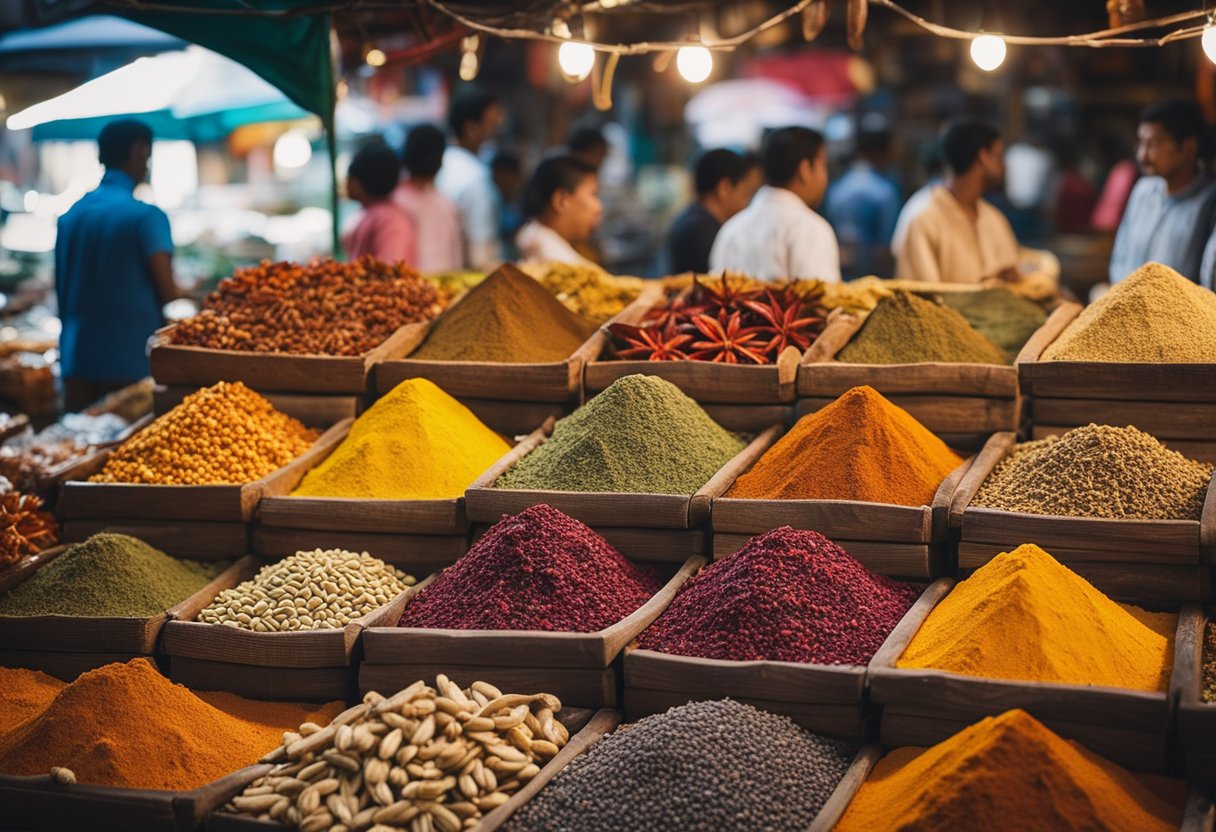
While exploring the vibrant Souks and Spice Markets of the Middle East and North Africa, we often come across unique souvenirs that serve as perfect keepsakes to cherish our memories. With their colourful array of items, these markets capture the essence of regional craftsmanship.
- Dubai‘s famous Souk Al Bahar is an iconic destination where the traditional meets the modern, offering a plethora of handicrafts and artisanal treasures.
- From opulent perfumes redolent with Arabian notes to the soft texture of silk scarves, each memento tells a story of our travel experiences.
| Souvenirs | Description | Sourced From |
|---|---|---|
| Handicrafts | Intricate works by local artisans. | Various Souks |
| Spices | Flavours that echo the zest of local cuisine. | Spice Markets |
| Silk | Luxurious fabrics with Middle Eastern patterns. | Souk Al Bahar, Dubai |
| Perfumes | Fragrant oils and incense with exotic scents. | Dubai & Beyond |
Whilst meandering through the narrow lanes of the souks, we’re enchanted by the scent of spices that waft through the air. These spices add flavour to our dishes and evoke fond memories of our travels once we return home.
- Listings of rare spices are often available, providing us with a tangible connection to the Middle Eastern gastronomic adventure.
- Local crafts include beautiful pottery, glassware, and intricate metalwork that exemplify the region’s rich historical and cultural heritage.
By taking home these souvenirs, we keep our travel memories alive and support the local economies and craftsmanship they represent.
The Importance of Gold and Jewellery in Trade
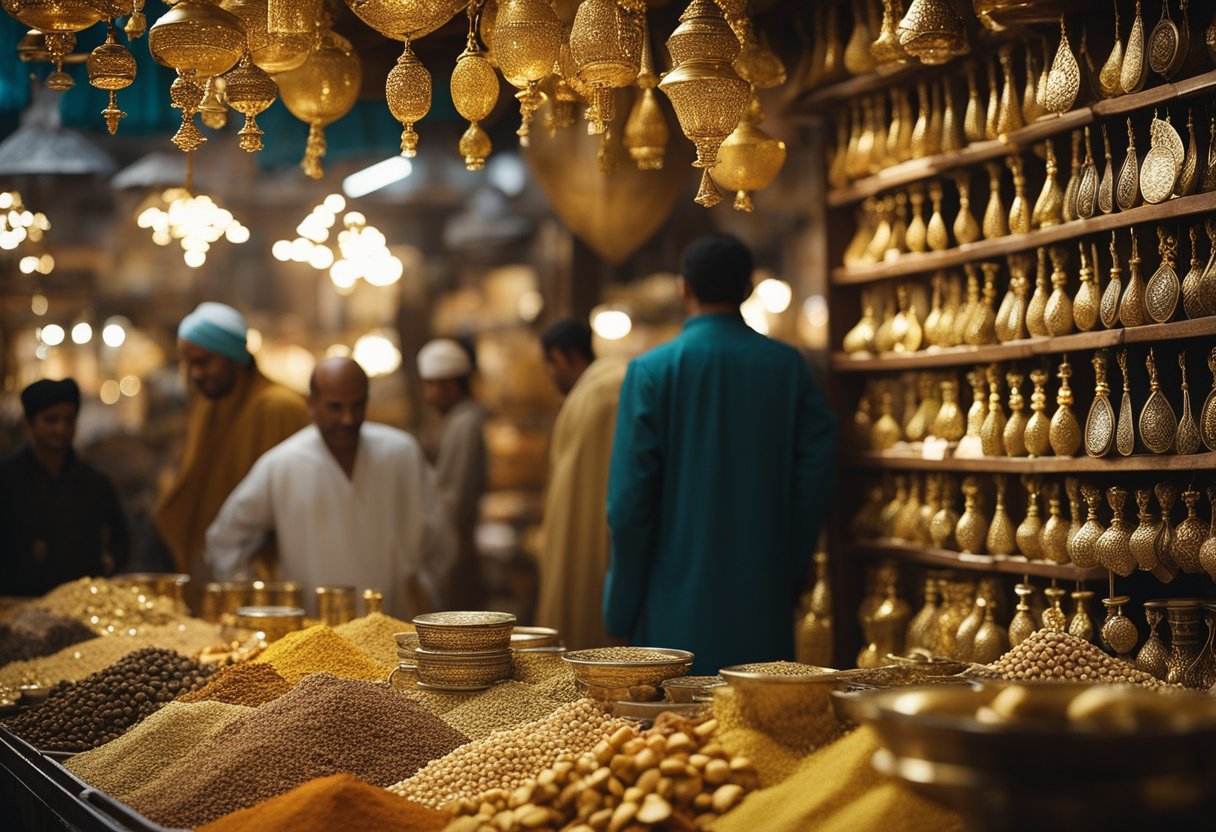
In trade history, gold and jewellery have always held a significant place. Their inherent value has made them crucial in trade relations and economic stability across the Middle East and North Africa. Gold, in particular, is a precious metal sought after for its beauty and function as a stable investment.
In cultures throughout the region, jewellery forms a part of the social fabric, often signifying status, wealth, and heritage. The pieces produced are not just accessories; they carry cultural stories and artisanal distinction. In the Dubai Gold Souk, for example, jewellery becomes a symbol of luxury and affluence, with the market being one of the most renowned gold hubs in the world.
| Commodity | Uses in Culture & Trade |
|---|---|
| Gold | Investment, Status Symbol, Ornamental Use |
| Jewellery | Cultural Significance, Trade Goods, Heirlooms |
As one walks through the Gold Souk, the luxury display is evident in every ornate piece’s glint. Traders from across the globe flock to the souk for the quality and design of the items available, reflecting the important role that gold trade plays in the global market. The souk has evolved to cater to a range of clients, offering everyday items to lavish pieces that capture the essence of luxury.
In our assessment, the trade of gold and jewellery remains a cornerstone of the Middle Eastern and North African economies. We understand that it complements their historical narratives and current economic goals, thriving globally due to unwavering demand.
We must also acknowledge that the allure of these markets extends beyond the metal’s value. It encompasses the skill of the craftspeople and the cultural significance of their intricate work, each piece a testament to centuries of tradition in goldsmithing and jewellery making.
Navigating the Souks: Travel Guide for Visitors
Preparation is key When visiting the Middle East and North Africa souks. We’ve outlined a guide to help you maximise your experience.
Before You Go
- Accommodation: Secure your stay in advance. Proximity to a metro station can save time and hassle.
- Currency: Ensure you have local currency; many vendors in the souks do not accept cards.
Getting There
- Use the Al Ras Metro Station to reach the Deira souks in Dubai, while an abra (a traditional boat) will take you across Dubai Creek to explore the other side.
While You’re There
- Orientation: Souks can be labyrinthine. A guide can help you navigate the enchanting narrow lanes of vendors.
- Souvenir Shopping: Expect to find everything from spices to textiles. Start with a friendly haggle, and never settle for the first price!
Best Practices
- Souk Madinat Jumeirah in Dubai offers a more contemporary shopping experience but retains the atmosphere of traditional souks.
- Yearly Visits: Plan according to the local calendar to avoid excessive heat or crowds during peak tourist seasons.
Practical Tips
- Stay Hydrated: Carry water with you to manage the heat, especially if you travel during the warmer part of the year.
- Respect Customs: Be mindful of local customs and dress codes, which convey respect for the culture.
By following these tips, we’re confident that you’ll have a fulfilling experience in the enchanting souks of the region.
Traditional and Modern Eateries Near Marketplaces
Adjacent to the vibrant souks and spice markets of the Middle East and North Africa are numerous eateries that cater to various palates.
Near Dubai Creek and the Al Seef area, Old Dubai showcases the harmonic blend of historical and contemporary dining. Eateries here often feature dishes with a base of aromatic rice adorned with spices such as saffron and cardamom. Menus highlight dates, nuts, and dried fruits, which are deeply ingrained in Middle Eastern cuisine.
Traditional Dining:
- Alfresco spots: Savour authentic Emirati dishes.
- Cafés: Enjoying teas infused with oud or incense.
Modern Dining:
- International Cuisine: A short stroll from local bazaars.
- Gourmet restaurants: In proximity to Bur Dubai and Dubai Mall.
In the old Souks, one can experience the hustle of merchants negotiating over exquisite textiles or craftsmen perfecting their wares. As day turns to dusk, these markets do not lose their appeal, with nearby eateries providing space for respite and replenishment. Within walking distance, visitors can indulge in entertainment options that fuse traditional performances with contemporary flair.
The food scene in these areas offers an immersive experience. Patrons can expect meals redolent with the scent of local spices, each bite a testament to the region’s rich tapestry of flavours.
Whether looking for an atmospheric dinner by Dubai Creek or a quick, indulgent bite amidst a day of shopping and exploration in Old Dubai, the proximity of traditional and modern eateries to these marketplaces enriches the journey of discovery for the taste buds as well as the spirit.
Events and Festivities in the Souk Calendar
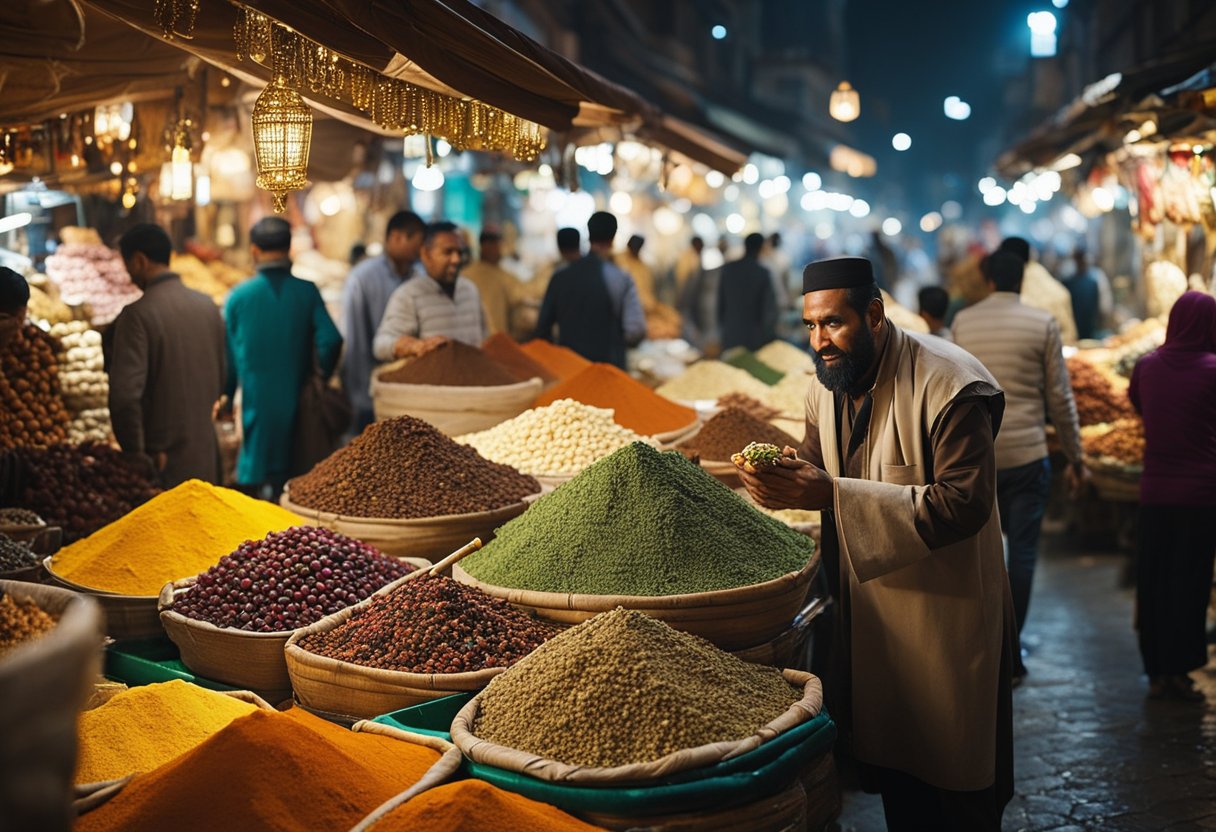
A calendar of events and festivities beckons within the vibrant labyrinth of Middle Eastern and North African souks. From the cultural enclaves of Dubai to the traditional marketplaces spread across the region, souks pulse with life, particularly during special occasions.
Souks amplify their charm during religious festivals, such as Ramadan and Eid al-Fitr, transforming into bustling centres of joy and celebration. During this period, visitors can witness various cultural performances, traditional music, and storytelling, encapsulating the region’s spirit.
In Dubai, the renowned Spice Souk takes on a festive air as local chefs and savvy expats congregate to procure their favourite flavours. The array of spices, from saffron strands to aromatic herbs, becomes even more appealing as vendors enthusiastically share the stories and origins of their goods with visitors, making souvenir shopping an interactive and memorable experience.
| Month | Event | Location | Highlights |
|---|---|---|---|
| December-January | Dubai Shopping Festival | Dubai Souks | Live entertainment, mega sales |
| April | Heritage Days | Across Middle Eastern Souks | Cultural performances, workshops on traditional crafts |
| May-June | Ramadan & Eid Celebrations | Various Souks | Night markets, special itineraries for evening shopping, traditional entertainment |
To enhance the souk itinerary, many markets also host food festivals accentuating local cuisine, where the sizzle of kebabs and the sweetness of fresh dates offer a sensory delight. The convergence of flavours builds bridges between people, cultures, and traditions.
Indeed, whether one seeks out the heady rush of Dubai’s souks during the Dubai Shopping Festival or a more intimate cultural exchange during the less frequented Heritage Days, these marketplaces serve as vibrant hubs of shared experiences and community gatherings. Every transaction is steeped in history, and every path leads to a story.
FAQs
In this section, we address some of the most common queries travellers have about the vibrant souks and spice markets across the Middle East and North Africa.
What items are commonly available for purchase in the souks of North Africa?
In North African souks, one can typically find a variety of handcrafted goods such as pottery, textiles, leather products, and intricate metalwork. Additionally, there’s an abundance of spices, local foods, and traditional clothing.
How does one negotiate prices effectively in the souks of Marrakech?
To effectively negotiate in Marrakech’s souks, it’s crucial to approach vendors with a polite yet firm demeanour. Begin by offering about one-third of the asking price and work gradually from there. Showing respect and having a friendly exchange can often lead to successful bargaining.
Which are the best-known spice markets in the Middle East, and how do they differ?
The best-known spice markets in the Middle East include Dubai’s Spice Souk and Istanbul’s Spice Bazaar. What sets them apart is their vast selection and the unique atmosphere of each market—Dubai offers a futuristic ambience amidst traditional trading, and Istanbul exudes historical charm.
What are the typical opening hours for souks in the Middle East region?
Souks in the Middle East typically open in the early morning and close in the late evening, often with a break in the afternoon. Some may close for Friday prayers. It’s advisable to check the specific opening times of each souk as they can vary.
Could you provide a guide to navigating the medinas and their souks?
Navigating the medinas requires a sense of adventure and patience. We recommend obtaining a map, using landmarks for navigation, and, if necessary, hiring a local guide. Be prepared for a labyrinth of alleyways filled with a bustling array of shops and stalls.
What distinguishes the largest souks in the Middle East from others in the region?
The largest souks, like the Grand Bazaar in Istanbul or the Khan El-Khalili in Cairo, are distinguishable by their sheer size, historical significance, and the wide variety of goods available. These hubs are shopping destinations and cultural landmarks steeped in history.






